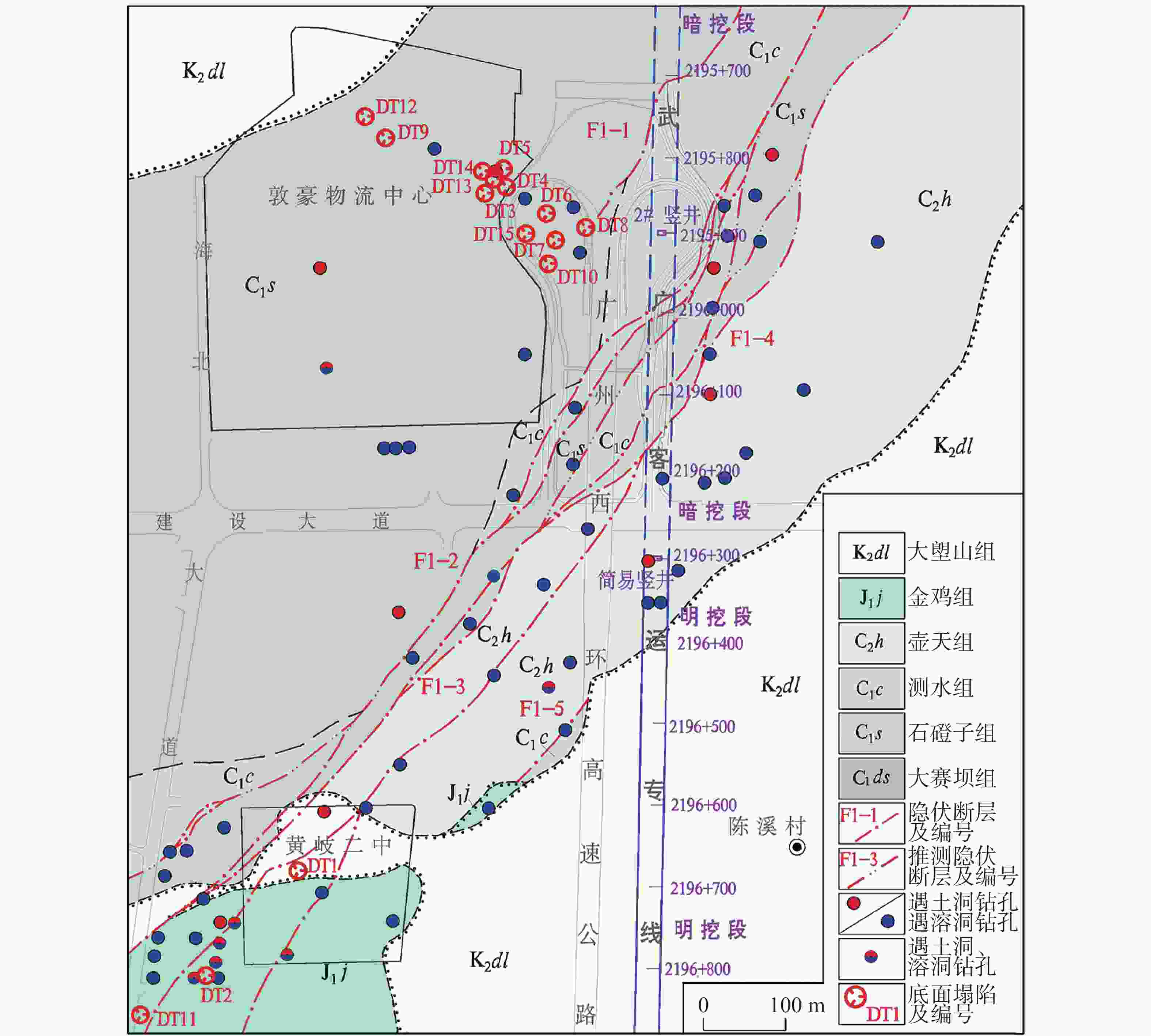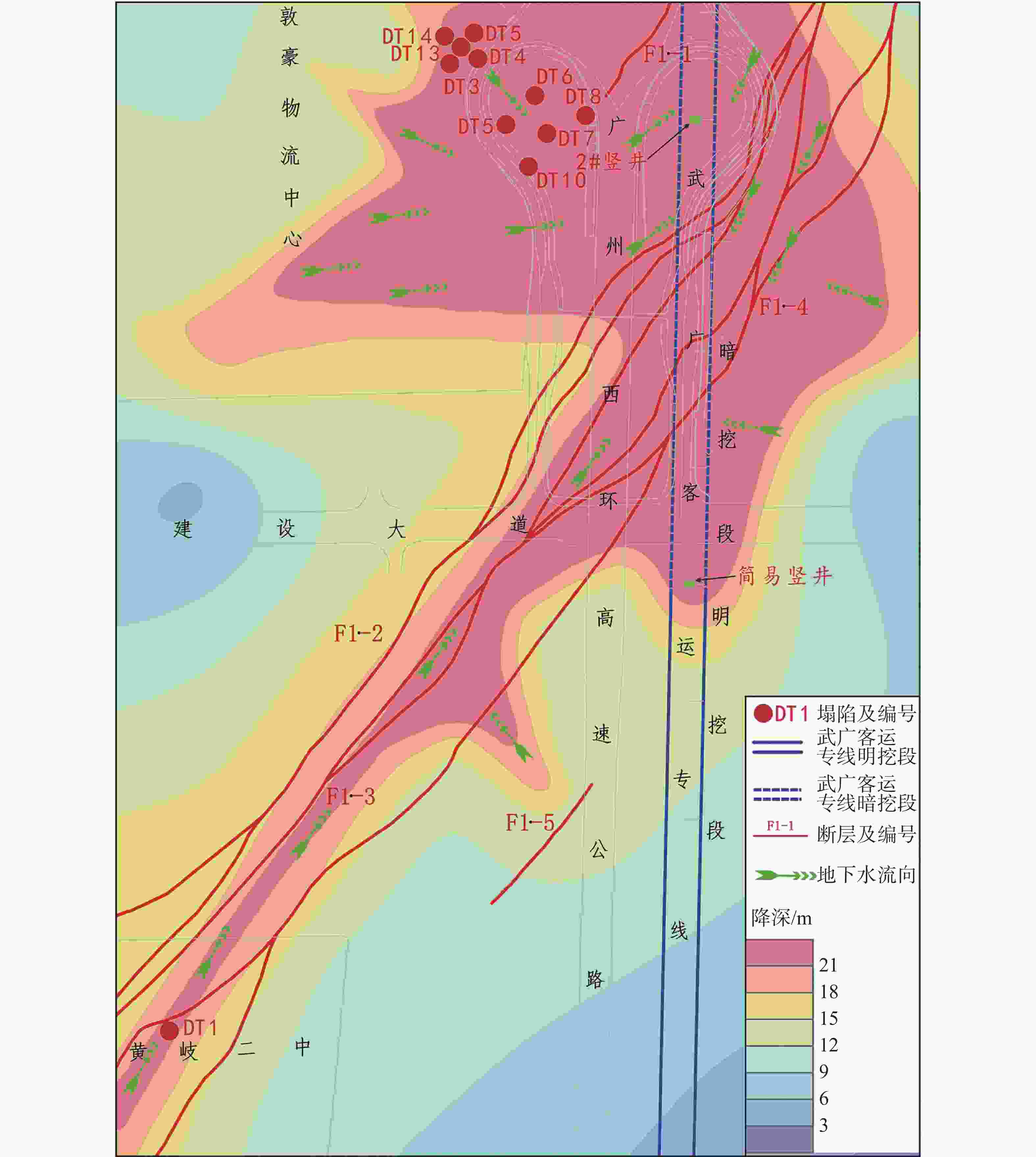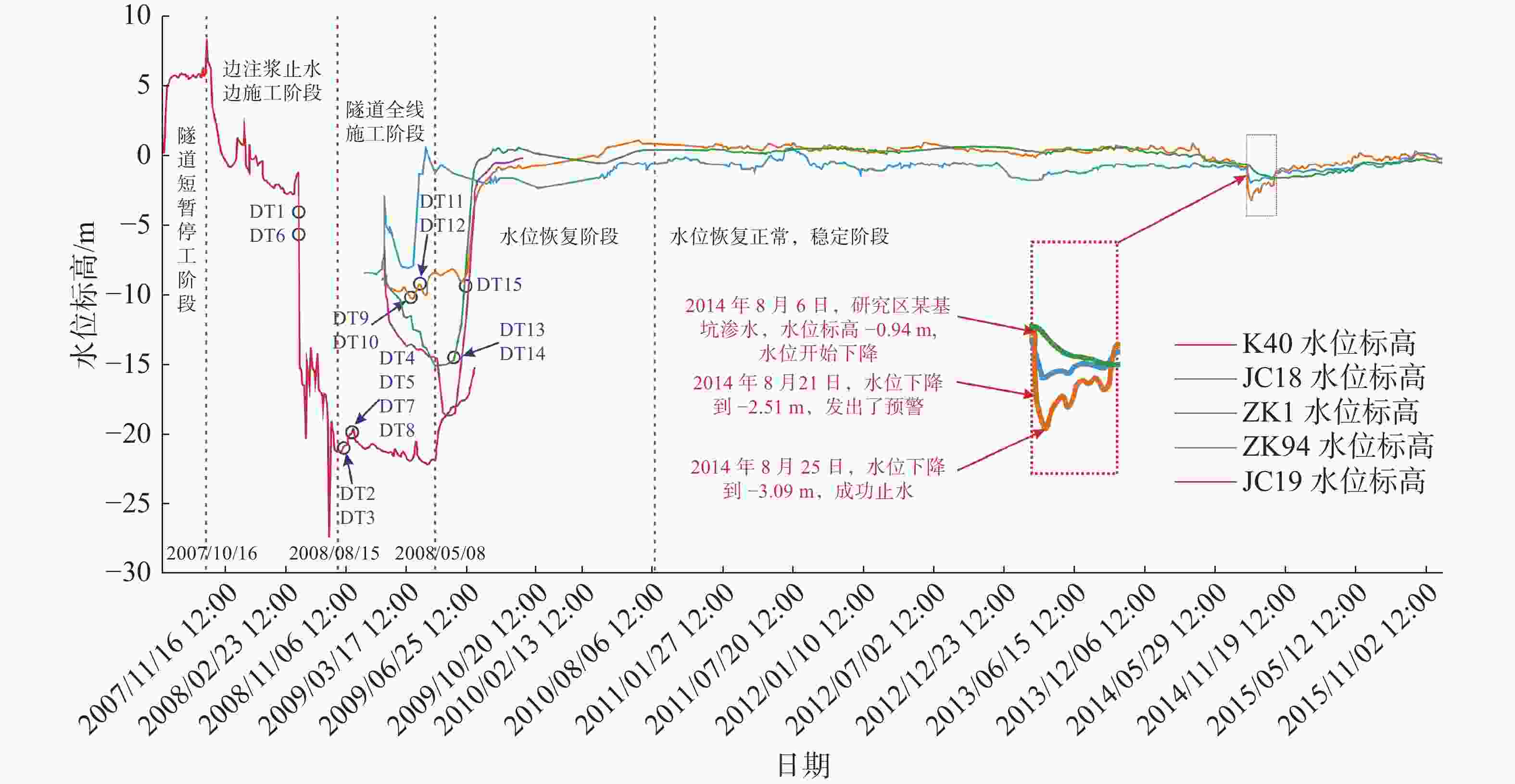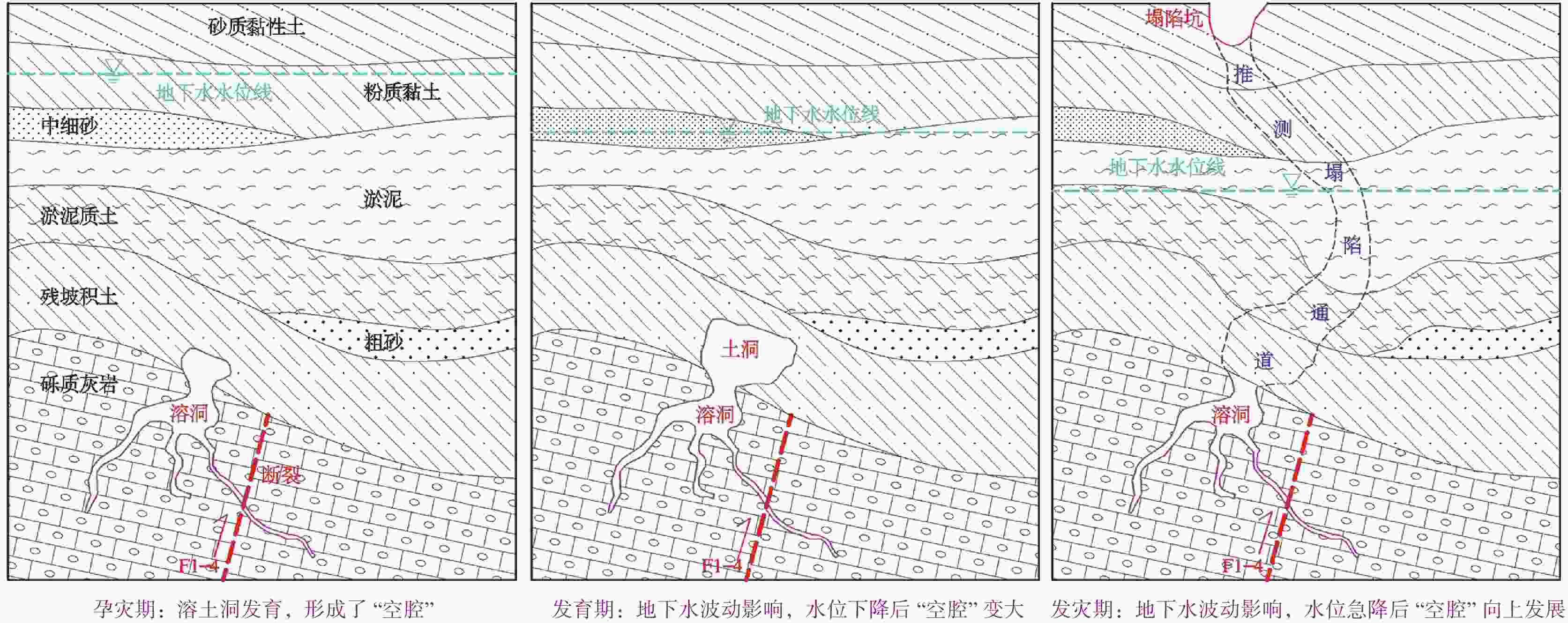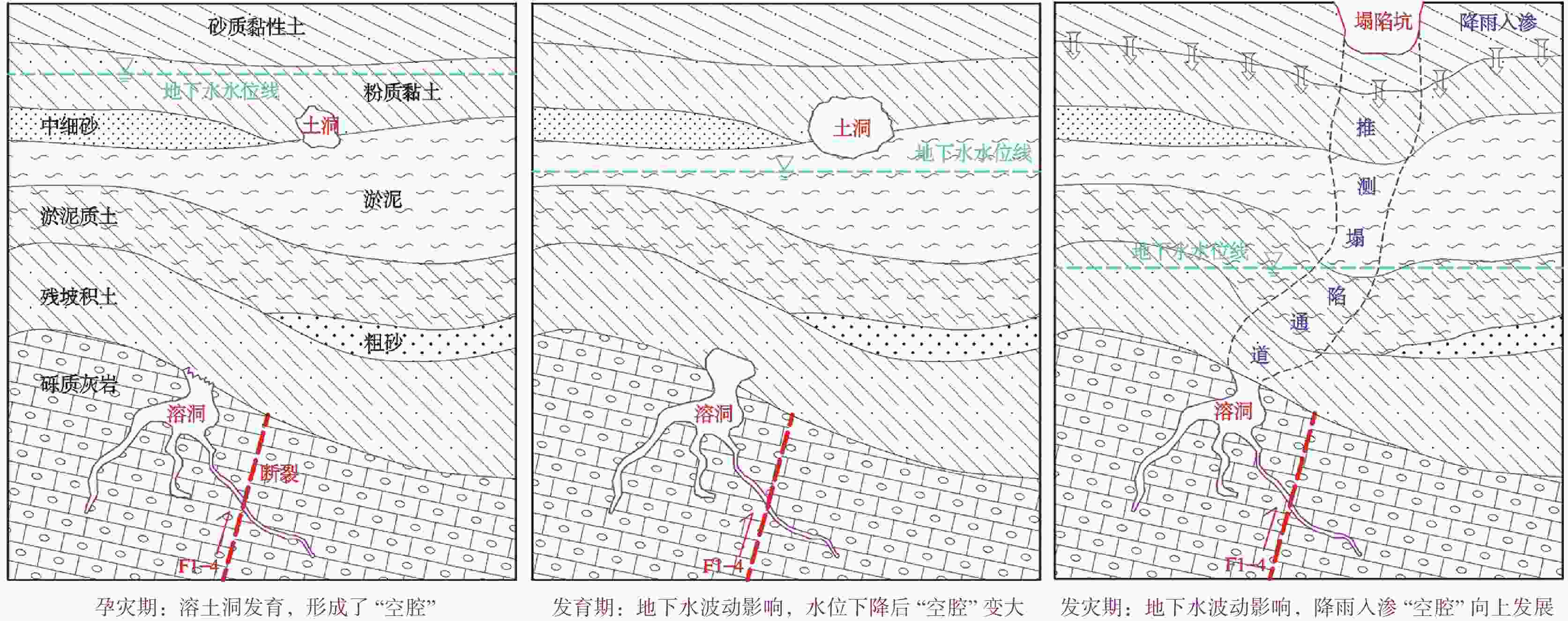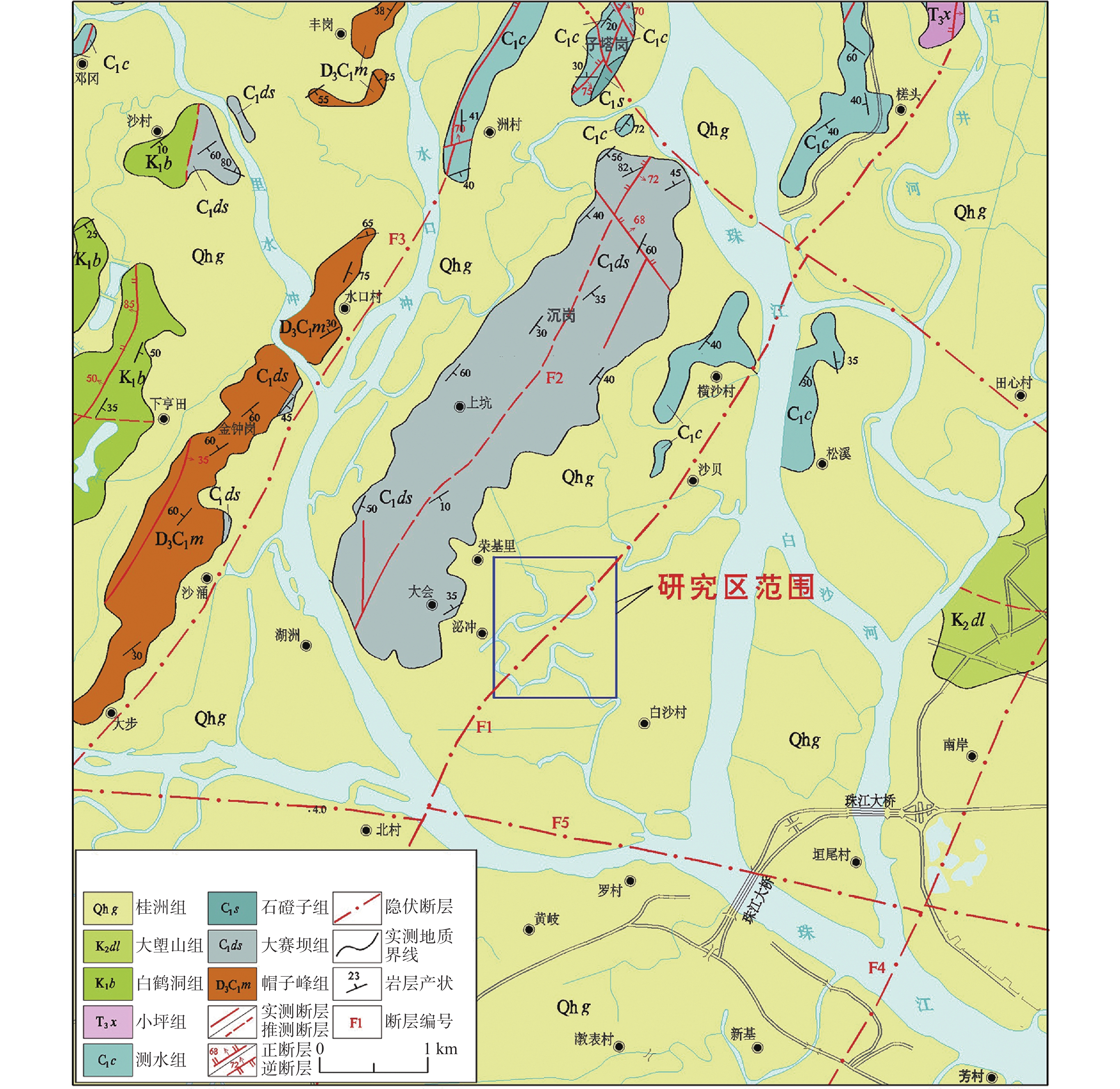Origin and trend analysis of karst collapse in Huangqi and Haibei communities, Foshan City
-
摘要: 佛山市南海区大沥镇黄岐海北片区地处珠江三角洲北部广花盆地边缘地带,第四纪软土、砂土以及隐伏岩溶发育,早期因区内人类工程活动强烈,诱发了群发性岩溶地面塌陷。文章在分析地质环境概况的基础上,研究了区内岩溶地面塌陷的发育特征和成因机理,认为溶洞土洞发育是先决条件,导水断裂发育是必要条件,因施工引发的地下水位下降是主要触发因素,F1断裂带附近仍具备发生岩溶塌陷的可能性,控制地下水水位标高在−3.0 m以内,地下水水位波动范围在1.5 m以内,可以大幅度降低岩溶塌陷发生概率,可以以此作为预警报警阈值。研究结果可以为佛山市城镇化建设过程中岩溶地面塌陷防治提供依据,也可以为其他类似地区防灾减灾提供借鉴。Abstract:
The study area is located in the eastern part of Michong village, north Huangqi community, Dali town, Nanhai district, Foshan City. Situated in the southern margin of Guanghua basin and the transitional zone between hilly region and plain region in the northern Pearl River Delta, the area is flat in terrain and convenient by transportation. The study area is characterized by wet spring, long hot summer, warm autumn and winter without frost, with south subtropical monsoon climate. The annual average temperature in this area is 21.9 °C with an annual average precipitation of 1,400-1,900 mm and a multi-year average of 1,613.5 mm. Rainfall is concentrated from April to September, accounting for about 80% of the whole year, and the multi-year average evaporation is 1,153 mm, which is generally less than the rainfall. In recent years, intensive human engineering activities such as the construction of high-speed rail, underground engineering of subway and pile foundation construction in the area have induced a large number of karst ground collapses and ground subsidence. Especially from February 2008 to September 2009, the affected area reached 1.2 km2, and 15 karst ground collapses occurred successively in the area, with the maximum land subsidence amounting to 87 cm. Damage, in different degrees, to Huangqi No.2 Middle School, DHL logistics Center, some factories and residential buildings was caused by the collapse and subsidence, in which more than 2,000 people were directly affected, and the direct economic loss was nearly 200 million yuan. The only exposed stratum in the study area is Holocene Guizhou formation (Qhg), but the hidden strata include lower Carboniferous ShiDengzi formation (C1s) and Ceshui formation (C1c), upper Carboniferous Hutian formation (C2h), lower Jurassic Jinji formation (J1j), upper Cretaceous Dayangshan formation (K2dl), and Quaternary residual layers (Qel). There is one fault zone with 5 groups in the study area, belonging to Shabei fault zone extending from the south-west direction of the fault zone. The fault zone provides a good channel for groundwater migration and favorable conditions for the development of karst caves, and then controls the development trend of karst in the area. The rock and soil mass in the study area is divided into 15 engineering geological layers from top to bottom, and the groundwater can be divided into four types, pore water of loose rock, fissure cave water of overlying carbonate rock, fissure water of overlying bedrock and fissure water of overlying red bed. Quaternary soft soil and sandy soil are relatively developed. Hidden karsts are developed in the study area. Of a total of 266 boreholes collected in the area, soil caves in 16 boreholes were exposed with a cave-spotting rate of about 6.35 %, and karst caves were exposed in 44 boreholes with a cave-spotting rate of 22%. In the study area, there have been 15 ground collapses accompanied by geological disasters such as ground subsidence over a large area. Though the collapse and subsidence did not cause casualties, they brought about damage to Huangqi No.2 Middle School, DHL Logistics Center, some factories and residential buildings. Huangqi No.2 Middle School was relocated on December 3,2008, and 1,300 teachers and students were evacuated. The disaster was then estimated as an oversize one, posing a huge impact on the economy and society of the study area at that time. The development characteristics and causative mechanisms of karst ground collapse in the study area, show that the development of karst caves and soil caves is the prerequisite; the development of water-conducting fractures is the necessary condition; and the construction precipitation is the main trigger factor. The formation mechanism is closely related to the fluctuation of groundwater level, whose types can be divided into "continuous groundwater decline decline", "continuous groundwater decline + rainfall infiltration", "recovery of rapid groundwater rise" and "rainfall infiltration". There is still possibility of karst collapse near F1 fault zone in the study area. Controlling the groundwater level elevation within −3.0 meters and the fluctuation range of groundwater level within 1.5 meters can greatly reduce the probability of karst collapse, which can be used as the warning threshold. The research results can provide a basis for prevention and control of karst ground collapse in urbanization of Foshan City, and also provide a reference for disaster prevention and reduction in other similar areas. -
Key words:
- karst collapse /
- mechanism /
- trend analysis /
- construction precipitation /
- water-conducting fracture /
- Foshan city
-
表 1 研究区地层单位特征概述
Table 1. Characteristics of stratigraphic unit in the study area
地 质 年 代 地层单位(代号) 岩性组合特征 第四纪全新世
—晚更新世桂洲组(Qhg) 淤泥、淤泥质土,黏土、粉质黏土、粉砂、细砂、中砂、粗砂 残积层(Qel) 黏性土、砂土,含碎石,局部发育土洞 白垩纪晚白垩世 大塱山组(K2dl) 棕红色、紫红色砂砾岩、粉砂岩、粉砂质泥岩、泥岩,底部为复成份砾岩,夹石膏 侏罗纪早侏罗世 金鸡组(J1j) 灰岩质砾岩,砾石成份为浅灰色、灰色、紫红色灰岩,次圆状,砾石大小1~6 cm,红色钙质胶结,该岩层溶洞十分发育 石炭纪晚石炭世 壶天组(C2h) 灰色、浅灰色,厚层状灰岩、生物碎屑灰岩、白云质灰岩,该岩层溶洞极其发育 石炭纪早石炭世 测水组(C1c) 深灰色、黄褐色粉砂岩、砂岩、泥岩及黑色炭质页岩为主,夹透镜状灰岩及煤线,该岩层发育少量溶洞 石磴子组(C1s) 深灰色、灰黑色灰岩、白云质灰岩、生物碎屑灰岩,夹少量炭质页岩、砂岩,灰岩缝合面发育有炭质薄膜,该岩层溶洞极其发育 表 2 研究区断裂特征概述
Table 2. Overview of fracture characteristics in the study area
断裂带名称 断层组 断层特征概述 广从断裂带
沙贝断裂F1-1断层 该断层向北东方向延伸;据武广客运专线隧道开挖工作面地质调查记录资料显示,构造岩为黑色强风化炭质页岩,分支断层较多,围岩走向与隧道轴线的夹角变化大,由0°~70°,结构面间距小于0.2 m或0.2~0.4 m,组数大于4组 F1-2断层 该断层向南西、北东方向延伸,两端各有分支断层与F1-3复合;构造岩为构造角砾岩、硅化碎裂岩、碎裂岩,岩石固结差,较松散,该断层具有多期活动特征 F1-3断层 该断层向南西、北东方向延伸,在中段及西南端有分支断层与F1-2复合;据武广客运专线隧道开挖工作面地质调查记录资料显示,断层带为碎石带,岩石风化严重,围岩走向与隧道轴线的夹角变化大,由0°~70°,结构面间距小于0.2 m或0.2~0.4 m,组数大于4组;构造岩为硅化碎裂岩、构造角砾岩,岩石固结性差,破碎、较松散 F1-4断层 该断层向南西分叉延伸,向北东方向与F1-3复合;下石炭统石磴子组(C1s)含炭质灰岩逆冲于白垩系褐红色砂岩之上,灰岩发育磨砾岩,红层泥岩片理化,岩芯强烈挤压破碎,构造岩为硅化碎裂岩,岩石强烈破碎 F1-5断层 该断层构造岩为构造角砾岩,角砾为1~5 cm,原岩为炭质泥岩、泥灰岩,岩石固结差,较松散 表 3 研究区岩土体特征概述
Table 3. Characteristics of rock and soil mass in the study area
地层带号 层序及岩性 土体/岩体特征表述 备注 Qml ⑴素填土 全分布,厚度0.80~6.10 m;紫红色、灰黄色,黏性土为主,含砂粒,局部见少量碎石、瓦片、砖块,稍经压实或松散。 透水性弱 Qmc ⑵淤泥、淤泥质土 广泛分布,厚度0.70~14.60 m;深灰色、灰色,流塑,味臭,污手,含有机腐殖质,局部夹淤泥质粉土、粉砂薄层 透水性极微 ⑶黏土、粉质黏土 广泛分布,厚度0.50~16.80 m;灰黄色、黄色、褐黄色,上部软塑,中下部可塑,黏性较强,局部含粉细砂或粗砂 透水性微弱 ⑷粉砂、细砂 局部分布,厚度0.30~11.26 m;浅灰、灰色,稍密为主,局部中密,饱和,分选较差,含泥质,局部上部由粉土逐渐过度到底部中粗砂 透水性弱-中等 ⑸淤泥质土 广泛分布,厚度1.20~13.60 m;浅灰色、灰色,流塑,味臭,污手,含有机腐殖质,局部含少量粉砂 透水性极微 ⑹黏土、粉质黏土 局部分布,厚度0.90~5.80 m;灰黄色、黄色、褐黄色,可塑,局部硬塑,黏性一般,局部含较多粉细砂或粗砂 透水性微弱
偶发土洞⑺粉砂、细砂 局部分布,厚度1.10~7.20 m;浅灰、灰色,局部灰黄色,稍密~中密,饱和,分选较差,含较多黏粒,局部夹粉土、粗砂或淤泥质土透镜体 透水性微弱 ⑻中砂、粗砂 透镜分布,厚度0.70~8.90 m;灰白色、灰黄色,石英颗粒为主,饱和,密实;分选差,含较多泥质,以中、粗砂为主,局部过渡为砾砂、圆砾 透水性中等 Qel ⑼残积土 广泛分布,厚度0.80~17.30 m;灰黄色,可塑,成份较杂,由粉质黏土和粗石英砂组成;土质差异较大,以黏粒、砂砾含量的不同,可分为粉质黏土、粉土、粉砂、中砂等 透水性微弱 C1c ⑽全风化砂岩 零星分布,厚度6.40 m;灰黄色,呈密实砂土状,质软,易捏碎 / C1c、K2dl ⑾强风化岩 零星分布,以泥质粉砂岩、泥岩、炭质页岩为主,厚度1.30~24.90 m,黑色、褐红色,岩质极软,岩石经风化呈半岩半土状,岩芯易磨损,手捏易碎;局部出现强风化灰岩等,厚度4.10~21.4 m,灰色,岩芯柱状,半岩半土状,岩质软,手捏易碎 / K2dl ⑿中风化砂岩、泥岩 局部分布,厚度1.00~13.50 m;棕红色,岩质软,岩芯较破碎,呈短柱状 / ⒀微风化泥岩、粉砂岩 局部分布,厚度2.20~6.50 m;褐红色,岩芯完整,呈中-长柱状,岩质坚硬,钻进缓慢 / J1j ⒁微风化灰岩质砾岩 局部分布,厚度0.9~6.00 m;红色、灰色,岩芯短柱状,灰岩成份为灰岩,次圆状,砾石大小1~6 cm,红色钙质胶结,厚层状,岩质坚硬,钻进慢,溶蚀现象较发育 溶洞发育层 C1s、C1c、C2h ⒂微风化灰岩 广泛分布,厚度0.10~26.70 m;浅灰色、灰色,岩芯短柱状、柱状,岩芯较完整,岩质坚硬,钻进慢,可见溶蚀现象 溶洞发育层 表 4 研究区地下水类型及富水等级划分
Table 4. Classification of groundwater types and grades of water abundance in the study area
地下水类型 地层代号 含水层岩性 富水性 单井涌水量/m3·d−1 断裂带的导水性 松散岩类
孔隙水Qmc 第一层:粉细砂
第二层:中砂、粗砂贫乏 <100 第四系松散层富水性贫乏、微-极微透水,覆盖层可视为隔水层,但局部含水层下伏基岩,构成径流补给通道 覆盖型碳酸盐岩
裂隙溶洞水C1s、
C2h、J1j灰岩、炭质灰岩、生物碎屑灰岩、白云质灰岩、灰岩质砾岩 中等 100~1 000 岩溶裂隙及溶洞连通性较好,断裂带是区内基岩地下水的主要通道 覆盖型
基岩裂隙水C1c 粉砂岩、炭质页岩 贫乏 <100 岩石破碎,完整性差,裂隙发育至极发育,加之断裂的破坏,其渗透性及透水性强 覆盖型
红层裂隙水K2dl 泥岩、泥质粉砂岩、砂岩 贫乏 <100 以泥岩为主,渗透性极弱 表 5 研究区溶洞发育特征概述
Table 5. Characteristics of karst cave development in the study area
地层代号 洞顶标高/m 溶洞高度/m 顶板厚度/m 同地层见洞率/% 分布结构及比例/% 充填物情况 C1s −9.46~−33.50 0.40~ 6.20 0.2~6.4 该层113个钻孔,17个揭露,占比15.04 单层结构:64.71
双层结构:23.53
三层结构:5.88
四层结构:5.88充填淤泥、黏粒、砂、泥炭、碎石等,全充填占比61.54%,半充填占比19.23%,无充填占比19.23% C1c −27.53 5.00 0.10 该层21个钻孔,1个揭露,占比4.76 单层结构 无充填物,严重漏水 C2h −11.63~−30.54 0.40~22.90 0.10~8.90 该层38个钻孔,12个揭露,占比31.58 单单层结构:91.76
双层结构:8.33充填软泥、黏粒、碎石等,全充填占比53.84%,半充填占比23.08%,无充填占比23.08% J1j −14.86~−31.72 0.70~6.20 0.50~11.5 该层28个钻孔,14个揭露,占比50.00 单层结构:92.86
双层结构:7.14充填软泥、黏粒、砂、碎石等,全充填占比20.00%,半充填占比60.00%,无充填占比20.00% 表 6 研究区岩溶塌陷地质灾害特征概述
Table 6. Geological disaster characteristics of karst collapse in the study area
编号 形状 规模/m 深度/m 面积/m2 发生时间 灾害情况 DT1 圆形 直径1.5 / 7 2008.2 位于黄岐二中操场,距武广客运专线平距约400 m,及时进行了回填 DT2 圆形 直径5 / 15 2008.10.3 黄岐二中西南约30 m的公园草地再次发生塌陷,距武广客运专线平距约540 m,及时进行了回填 DT3 近圆形 直径2.2 0.50 4 2008.11.4 位于泌冲村敦豪物流中心东北部B2栋南侧发生塌陷,及时进行了填埋;塌陷坑距武广客运专线平距约200 m DT4 近圆形 直径2.2 0.40 初始4
扩至212008.11.11 位于DT3北约10 m再次发生塌陷,塌陷坑未及时处理,2008年12月18日塌陷坑扩大一倍;塌陷坑距武广客运专线平距约200 m DT5 椭圆形 长轴2.2,
短轴1.80.60 2.5 2008.11.30 位于DT4塌陷坑西约3 m处再次发生的塌陷,塌陷坑距武广客运专线平距约200 m DT6 椭圆形 长轴3.8,
短轴3.01.65 9 2008.2 此3个塌陷坑位于广州西环浔峰洲南行入口环岛内侧,距武广客运专线平距约150 m。呈近东西向排列,DT6位于最西面,DT8位于最东面,DT7位于DT6塌陷坑东约10 m,DT8位于DT7塌陷坑东约4.2 m
DT7和DT8与敦豪物流中心内三个塌陷发生时间基本一致DT7 椭圆形 长轴6.5,
短轴5.04.00 30 2008.11 DT8 圆形 直径4.0 2.00 12 2008.11 DT9 圆形 直径4.2 0.55 21 2009.3.19 位于泌冲村敦豪物流中心西北部 DT10 近圆形 直径3.5 1.50 10 2009.3.19 同在DT9东侧广州西环高速浔峰洲入口环岛内侧DT6塌陷坑西南约6 m处 DT11 椭圆形 长轴9.0,
短轴7.01.00 50 2009.4.4 位于南海区大沥镇黄岐海北片区泌冲永澄村海北大道西侧人行道上 DT12 圆形 直径1.3 1.50 2 2009.4.8 位于泌冲村敦豪物流中心西北部东侧DT9南约3 处 DT13 圆形 直径5.5 3.50 25 2009.6.16 位于泌冲村敦豪物流中心南门,距离南门收费亭以北约5 m的道路中间处 DT14 近圆形 直径6.7 / 30 2009.6.12 位于敦豪物流中心东北部B2栋南侧,DT5塌陷坑西约3 m处 DT15 近圆形 直径3.4 3.30 10 2009.6.26 位于广州西环浔峰洲南行入口环岛内侧DT6塌陷坑西南约3 m处 -
[1] 国家统计局佛山调查队. 2019年佛山市国民经济和社会发展统计公报[R]. 佛山市统计局, 2020Foshan Investigation Team of National Bureau of Statistics. Statistical Bulletin of Foshan National Economic and Social Development in 2019 [R]. Foshan Statistics Bureau, 2020. [2] 国务院办公厅. 国务院办公厅关于佛山市城市总体规划的通知(国办函〔2016〕107号)[EB]. 2016General Office of the State Council. Notice on the overall planning of Foshan City[EB]. 2016 [3] 张宗胜, 易守勇, 黄继春, 马 威, 黄芝惠, 叶伟何, 赵亚甜, 廖恒源, 任 荣, 罗 鑫, 邱瑞山, 杨 帆. 广东省佛山市南海区大沥镇黄岐海北片区地质灾害勘查报告[R]. 广东省佛山地质局, 2009ZHANG Zongsheng, YI Shouyong, HUANG Jichun, MA Wei, HUANG Zhihui, YE Weihe, ZHAO Yatian, LIAO Hengyuan, REN Rong, LUO Xin, QIU Ruishan, YANG Fan. Geological hazard investigation report of Huangqi Haibei area, Daili Town, Nanhai District, Foshan City, Guangdong Province[R]. Foshan Geological Bureau of Guangdong Province, 2009. [4] 张宗胜, 马威, 易守勇, 谭新强, 贝永辉, 易国雄, 黄芝惠, 叶伟何, 黄继春, 劳贤昌. 广东省佛山市南海区桂城街道夏北片区地面沉降地质灾害勘查报告[R]. 广东佛山地质工程勘察院, 2009ZHANG Zongsheng, MA Wei, YI Shouyong, TAN Xinqiang, BEI Yonghui, YI Guoxiong, HUANG Zhihui, YE Weihe, HUANG Jichun, LAO Xianchang. Geological disaster investigation report of ground collapse of Xiabei area, Guicheng Street, Nanhai District, Foshan City, Guangdong Province[R]. Guangdong Foshan Geological Engineering Survey Institute, 2009 [5] 张宗胜, 马威, 李锋, 张涛, 黄焕强, 黄冠滔, 黄芝惠, 叶伟何, 黄继春, 易守勇, 廖恒源, 毛政球, 向新生. 广东省佛山市高明区荷城街道富湾安华路地面塌陷地质灾害勘查报告[R]. 广东佛山地质工程勘察院, 2011ZHANG Zongsheng, MA Wei, LI Fong, ZHANG Tao, HUANG Wenqiang, HUANG Guantao, HUANG Zhihui, YE Weihe, HUANG Jichun, YI Shouyong, LIAO Hengyuan, MAO Zhengqiu, XIANG Xinsheng. Geological disaster investigation report of ground collapse of Fuwan Anhua Road, Hecheng Street, Gaoming District, Foshan City, Guangdong Province[R]. Guangdong Foshan Geological Engineering Survey Institute, 2011 [6] 潘成球. 广东省佛山市顺德区乐从镇沙滘东村地面沉降区岩土工程勘察与监测报告[R]. 广东省佛山地质局, 2011PAN Chengqiu. Geotechnical engineering investigation and Monitoring report of Land subsidence area of Dongcun, Shajiao, Lechong Town, Shunde District, Foshan City, Guangdong Province[R]. Guangdong Foshan Geological Engineering Survey Institute, 2011 [7] 彭峰. 广东省佛山市顺德区乐从镇小涌村地面沉降地质灾害应急调查报告[R]. 广东省环境监测总站, 广东省佛山地质局, 2011PENG Feng. Geotechnical disaster emergency investigation report of Land subsidence of Xiaocong village, Lechong town, Shunde district, Foshan City, Guangdong Province[R]. Guangdong Provincial Geological Environment Monitoring Station, Guangdong Foshan Geological Engineering Survey Institute, 2011. [8] 欧智德, 罗锡宜, 邵山, 郐毅智, 龙家耀, 张忠进, 吴克宁. 广东省佛山市禅城区南庄镇瓷海国际地面沉降地质灾害调查报告[R]. 广东佛山地质工程勘察院, 2011OU Zide, LUO Xiyi, SAO Shan, GUI Yizhi, LONG Jiayao, ZHANG Zhongjin, WU Kening. Geotechnical disaster investigation report of land subsidence of Cihai international, Nanzhang town, Shunde district, Foshan City, Guangdong Province[R]. Guangdong Foshan Geological Engineering Survey Institute, 2011. [9] 董好刚, 黄长生, 陈雯, 张宏鑫, 支兵发, 赵信文. 珠江三角洲环境地质控制性因素及问题分析[J]. 中国地质, 2012, 39(2): 539-549DONG Haogang, HUANG Changsheng, CHEN Wen, ZHANG Hongxin, ZHI Bingfa, ZHAO Xinwen. The controlling factors of environment geology in the Pearl River Delta Economic Zone and an analysis of existing problems[J]. Geology in China, 2012, 39(2): 539-549. [10] 黄继春, 罗锡宜, 李日伟, 廖恒源, 邓飞, 戴春, 骆邵军, 任荣, 刘放. 佛山市城市地质调查报告(2010年度)[R]. 广东省佛山地质局, 2011HUANG Jichun, LUO Xiyi, LI Riwei, LIAO Hengyuan, DENG Fei, DAI Chun, LUO Shaojun, REN Rong, LIU Fang. Urban geological survey report of Foshan City(2010year)[R]. Foshan Geological Bureau of Guangdong Province, 2011 [11] 蒙彦, 雷明堂, 贾龙. 1∶5万珠三角地区岩溶塌陷地质灾害调查[R]. 中国地质调查局MENG Yan, LEI Mingtang, JIA Long. 1∶50,000 Geotechnical disaster investigation report of karst collapse in the Pearl River Delta[R]. China Geological Survey. [12] 韩庆定, 罗锡宜, 易守勇, 邹杰, 徐明宇, 陈胜, 彭峰, 陈裕明, 赖桂林, 黄少飞, 欧智德, 谭新强, 廖恒源, 任荣. 广东省城镇典型岩溶地面塌陷防治研究[R]. 广东省佛山地质局, 2011HAN Qingding, LUO Xiyi, YI Shouyong, ZOU Jie, XU Mingyu, CHEN Sheng, Peng Feng, CHE Yuming, LAI Guilin, HUANG Shaofei, OU Zide, TAN Xinqiang, LIAO Hengyuan, REN Rong. Prevention and comtrol research of typical karst ground collapse in The Town Guangdong Province[R]. Foshan Geological Bureau of Guangdong Province, 2011. [13] 蒙彦, 郑小战, 雷明堂, 李卓骏, 贾 龙, 潘宗源. 珠三角地区岩溶分布特征及发育规律[J]. 中国岩溶, 2019, 38(5):746-751.MENG Yan, ZHENG Xiaozhan, LEI Mingtang, LI Zhuojun, JIA Long, PAN Zongyuan. Karst distribution and development in the Pearl River Delta[J]. Carsologica Sinica, 2019, 38(5):746-751. [14] 张永定, 张澄博, 李洪艺, 梁森荣, 邱锦安, 陈仲如, 林涛. 广州市西北区岩溶分布规律浅析[J]. 热带地理, 2011, 31(3):257-261. doi: 10.3969/j.issn.1001-5221.2011.03.005ZHANG Yongding, ZHANG Chengbo, LI Hongyi, LIANG Senrong, QIU Jin'an, CHEN Zhongru, LIN Tao. Distribution characteristics of karst in northwestern Guangzhou[J]. Tropical Geography, 2011, 31(3):257-261. doi: 10.3969/j.issn.1001-5221.2011.03.005 [15] 刘江龙, 刘会平, 吴湘滨. 广州市地面塌陷的形成因与时空分布[J]. 灾害学, 2007, 22(4):62-65. doi: 10.3969/j.issn.1000-811X.2007.04.014LIU Jianglong, LIU Huiping, WU Xiangbin. Mechanism and temporal-spatial distribution of ground collapse in Guangzhou[J]. Journal of Catastrophology, 2007, 22(4):62-65. doi: 10.3969/j.issn.1000-811X.2007.04.014 [16] 罗锡宜, 韩庆定, 邹杰, 易守勇. 佛山市高明区西江新城及周边岩溶发育规律探讨[J]. 华南地震, 2017, 37(2):34-38.LUO Xiyi, HAN Qingding, ZOU Jie, YI Shouyong. Study on karst development law of xijiang new town and surrounding area in Gaoming district of Foshan[J]. South China Journal of Seismology, 2017, 37(2):34-38. [17] 韩庆定, 罗锡宜, 易守勇, 邹杰. 广东佛山市高明区三洲盆地岩溶塌陷发育特征与时空分布规律[J]. 中国地质灾害与防治学报, 2021, 32(3): 131-139HAN Qingding, LUO Xiyi, YI Shouyong, ZOU Jie. Characteristics and spatial-temporal distribution law of karst collapse in Sanzhou basin in Gaoming District of Foshan City, Guangdong Province[J]. The Chinese Journal of Geological Hazard and Control, 2021, 32(3): 131-139. [18] 郑晓明, 金小刚, 陈标典, 刘鹏瑞, 杨戈欣, 李海涛, 杨涛. 湖北武汉岩溶塌陷成因机理与致塌模式[J]. 中国地质灾害与防治学报, 2019, 30(5):75-82. doi: 10.16031/j.cnki.issn.1003-8035.2019.05.10ZHENG Xiaoming, JIN Xiaogang, CHEN Biaodian, LIU Pengrui, YANG Gexin, LI Haitao, YANG Tao. Mechanism and modes of Karst collapse in Wuhan City, Hubei Province[J]. The Chinese Journal of Geological Hazard and Control, 2019, 30(5):75-82. doi: 10.16031/j.cnki.issn.1003-8035.2019.05.10 [19] 蒙彦, 黄健民, 贾龙. 基于地下水动力特征监测的岩溶塌陷预警阈值探索:以广州金沙洲岩溶塌陷为例[J]. 中国岩溶, 2018, 37(3):408-414.MENG Yan, HUANG Jianmin, JIA Long. Early warning threshold of sinkhole collapse based on dynamic characteristics from groundwater monitoring: A case study of Jinshazhou of Guangzhou, China[J]. Carsologica Sinica, 2018, 37(3):408-414. [20] 郑小战. 广花盆地岩溶地面塌陷灾害形成机理及风险评估研究[D]. 长沙: 中南大学, 2009ZHENG Xiaozhan. Research on genetic mechanism and risk evaluation of the karst collapse in Guanghua Basin[D]. Changsha: Central South University, 2009 [21] 包全坡. 珠三角岩溶地区桥梁桩基成孔技术[J]. 江苏建筑, 2012(6):75-77. doi: 10.3969/j.issn.1005-6270.2012.06.026BAO Quanpo. Bridge pile foundation drilling technology in karst area of Pearl River Delta[J]. Jiangsu Construction, 2012(6):75-77. doi: 10.3969/j.issn.1005-6270.2012.06.026 [22] 冯亚伟. 山东省岩溶塌陷分布规律及成因机制[J]. 中国岩溶, 2021, 40(2):205-214.FENG Yawei. Distribution and genesis of karst collapse in Shandong Province[J]. Carsologica Sinica, 2021, 40(2):205-214. [23] Sophie Messerklinger. Formation mechanism of large subsidence sinkholes in the Lar valley in Iran[J]. Quarterly Journal of Engineering Geology and Hydrogeology, 2014(47):237-250. [24] 黄健民, 吕镁娜, 郭宇, 陈小月. 广州金沙洲岩溶地面塌陷地质灾害成因分析[J]. 中国岩溶, 2013, 32(2):167-174. doi: 10.3969/j.issn.1001-4810.2013.02.007HUANG Jianmin, LV Meina, GUO Yu, CHEN Xiaoyue. Research on the for geologic disaster by karst reason surface collapse at Jinshazhou in Guangzhou[J]. Carsologica Sinica, 2013, 32(2):167-174. doi: 10.3969/j.issn.1001-4810.2013.02.007 [25] 黄健民, 邓雄文, 胡让全. 广州金沙洲岩溶地下水变化与地面塌陷及地面沉降关系探讨[J]. 中国地质, 2015, 42(1):300-308. doi: 10.3969/j.issn.1000-3657.2015.01.024HUANG Jianmin, DENG Xiongwen,HU Rangquan. The relationship between groundwater and ground collapse and land subsidence in Jinshazhou, Guangzhou City[J]. Geology in China, 2015, 42(1):300-308. doi: 10.3969/j.issn.1000-3657.2015.01.024 -




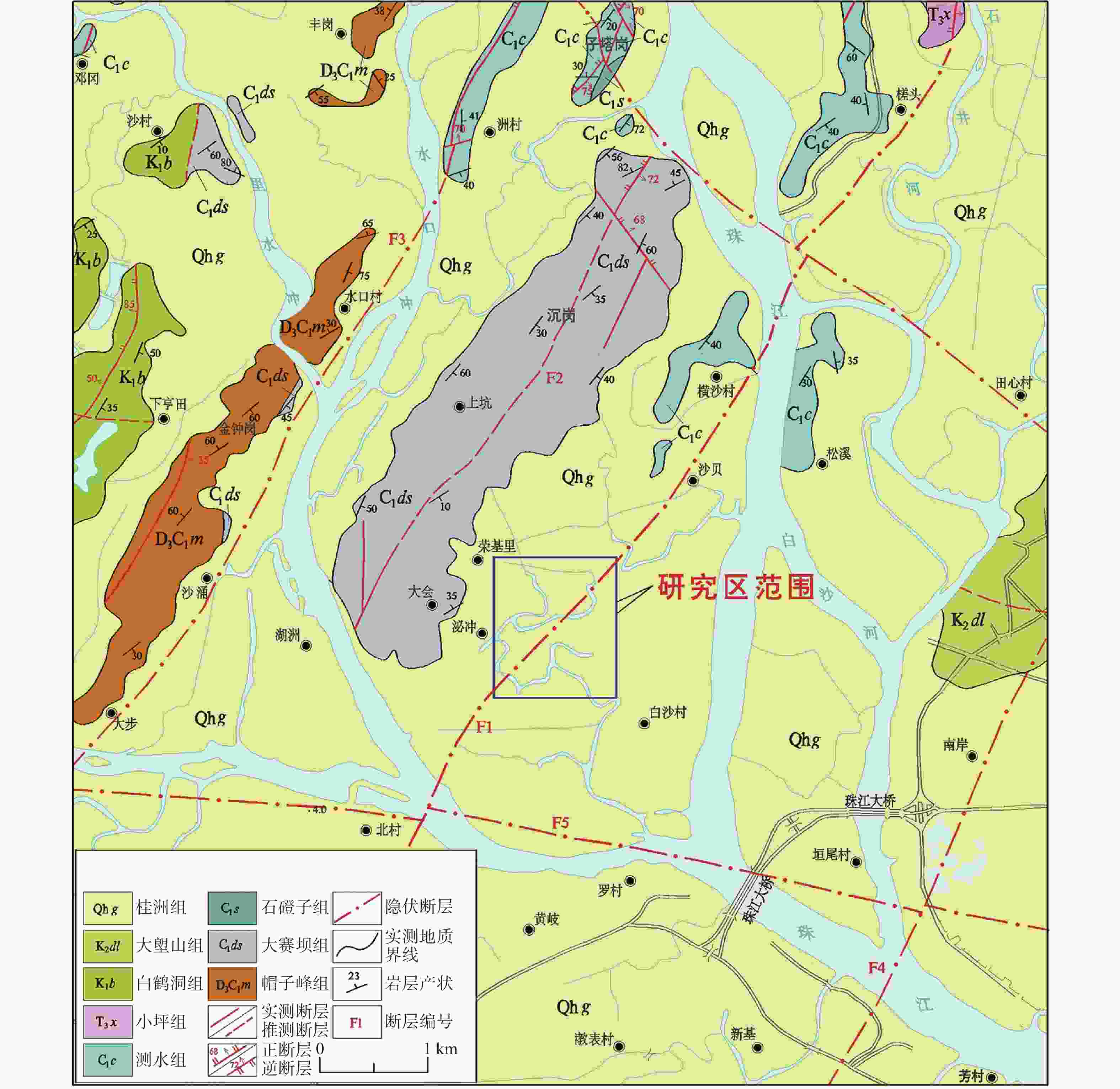
 下载:
下载:
